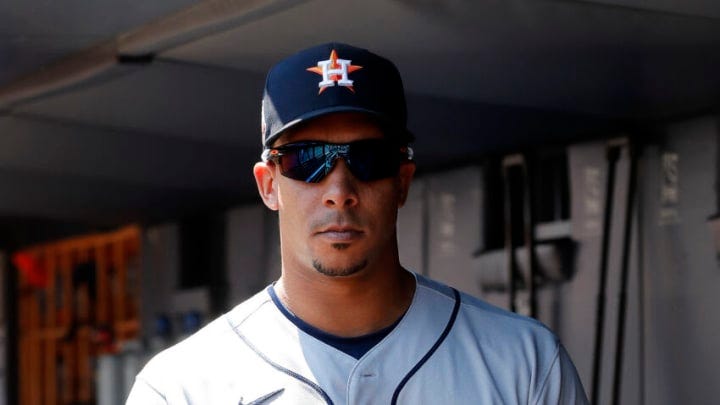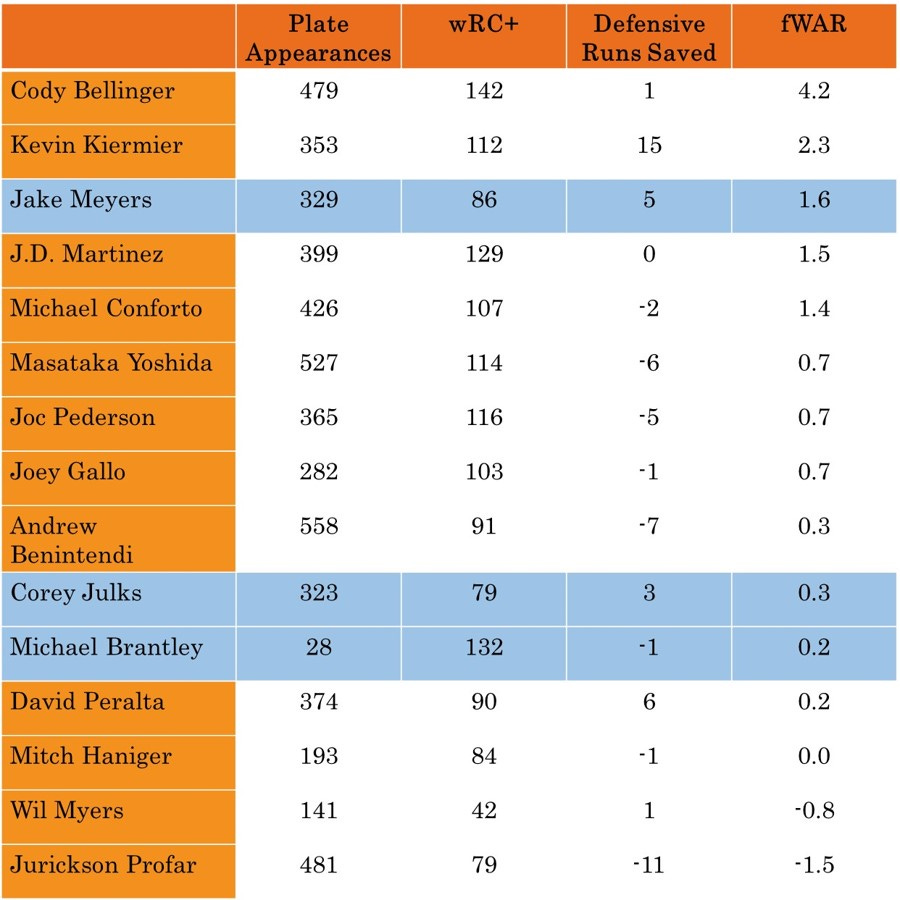Are Free Agents Worth It? The Case of Michael Brantley Suggests The Answer is No
Michael Brantley's injury has kept him off of the field. But the other outfielders signed this offseason are hardly any better. What lessons can we learn about signing free agents
In December when the Jim Crane-led front office signed Michael Brantley, I headlined my analysis of the move “The Steady Michael Brantley Was the Best of the Flawed Choices for Left Field.”
The choice to sign Brantley has not worked out well for the Astros to this point. Brantley’s shoulder injury was worse than thought at the time and he spent the better part of five months on the injured list with a sore shoulder. The Astros have eased him back since activating Brantley on August 29th—he has started 8 of the Astros 12 games since then.
Due to the injury, Brantley will not provide a ton of regular season value to the Astros for their investment in him.
And yet, looking back at the Astros options this off-season, it is not clear they made a terrible choice. The vast majority rest of the options were indeed, as I wrote in December, flawed.
Below is a chart that shows the free agent outfielders from the class of 2022 that signed for five years of less. For comparison purposes, I also included the two Astros who got the most playing time as a result of Brantley’s long injury—Jake Meyers and Corey Julks. The chart is sorted by fWAR.
One obvious conclusion from this list is that there were not a lot of good options in the outfield among free agents this offseason. A 2.0 WAR player is considered an average major leaguer, and by that standard, only two of the free agent outfielders from this past class meet this standard—Cody Bellinger and Kevin Kiermeier.
My analysis that the choices were flawed was accurate indeed.
Another conclusion that I reach is that defense matters a lot. Kiermeier rises in value over other outfielders with similar offensive numbers due to his excellent defense in center field. Bellinger has slumped since his Gold Glove season in 2019, but still provides positive offensive value.
A number of these players have slumped defensively this season—Benintendi and Gallo especially. While others, like Joc Pederson, have never been strong defenders. One can see how Masataka Yoshida’s poor defense is dragging down his value.
Jake Meyers has the third highest fWAR on this list and that is primarily due to his plus defense in center field. Meyers was also important reason why I thought signing Brantley was the best of the Astros options this offseason.
I thought the Astros could manage that because a McCormick/Meyers/Tucker combo is “an outstanding defensive outfield. That provides a high floor for the team next year, even with a starter like Brantley on the IL.”
That bit of analysis has borne itself out. Meyers has not hit great (his 86 wRC+ is 11% worse than the 97 that Steamer projected him for in the offseason), but he has been among the handful of best defensive centerfielders in baseball, and that has provided quality value as a fourth outfielder.
Of course, as the chart shows, Corey Julks has received as much playing time as Meyers and that has worked out less well. Julks has hit worse than even Meyers and has provided less defensive value.

Are Free Agents Just Lottery Tickets?
Obviously, there is one superior option that, with the gift of hindsight, we know the Astros “should” have signed among these candidates—Cody Bellinger. I had identified Bellinger as a “mystery box candidate” who the Cubs had signed “on the hopes that he bounces back from his horrendous last three years.” That bet has paid off.
But overall, it’s a one in ten—or two in ten if you include Kiermier—hit rate on free agent outfielders this offseason. All but two of the teams that signed these players would have been better off trading for Jake Meyers this offseason than going with the player they signed.
So perhaps the lesson is that teams should avoid free agency. They are all mystery box candidates. Free agents are by definition older players and thus are more injury prone and usually past their defensive peak. One can see in the playing time and fWAR numbers how that is true for this group of free agents. Few have played a full season and many hurt their team when they wear gloves.
The best way to avoid the vagaries of signing free agents to positions of need is not have positions of need. Instead, a team can have its own good players who can fill in holes caused by aging, injuries, and free agency departures. Jake Meyers is no superstar, but he’s a helpful contributor and has smoothed the loss of Brantley.
Some of these free agents (e.g. Jurickson Profar, Joey Gallo, Wil Myers) have lost playing time to younger internal options that their teams developed this season (e.g. Nolan Jones, Matt Wallner, Will Benson).
The other lesson may be that if you go for a free agent, go big. I cut off the list of free agents at those who signed for less than five years because Jim Crane has an informal rule that he will not sign a contract for more than five free agent years. Those who sign for longer are not really candidates for the Astros to sign.
But that cuts off two players who signed for longer—Aaron Judge and Brandon Nimmo, who signed a nine and an eight year contract respectively. Each has been worth their contract so far this season. Judge has been worth 3.9 fWAR despite a long stint on the IL, and Nimmo has been worth 3.5 with the Mets. Both teams have disappointed, but it is primarily due to these men’s teammates.
So maybe the lesson is that you get what you pay for. Pay up, and a team can get excellent players like Judge and Nimmo. Rummage through the bargain bin and you’re essentially playing the lottery to get someone better than Jake Meyers.
Dana Brown, Jim Crane and the rest of the front office will have to sort through these potential lessons as the front office thinks about how to approach the 2023 offseason. Since Brantley signed a 1 year contract, they will once again have to decide what to do in left field, and whether to pursue an external option or to rely on Meyers, Julks, and others inside the organization.
For us fans, that’s something to think about in November. For right now, the good news is that Michael Brantley is finally healthy enough to be on the active roster. And so far, he looks like Michael Brantley, and not like a guy whose shoulder is too injured to be effective. And like I wrote in December, “It’s more important to have Brantley in the lineup in October than any random game in June.”
Here’s hoping.





Like you, I was surprised to see the defensive metrics weigh so heavily. For a moment I had to do a double-take to confirm you used fWAR instead of bWAR (the latter of which is often critiqued for placing too much value on defensive metrics).
I’m not sure I entirely agree with your conclusion that teams should avoid free agency altogether (or exclusively swing big therein). As Brantley’s prior free agent contracts showed us, there’s value to be had out there (2019: 3.8 fWAR; 2020:* 1.1 fWAR; 2021: 2.3 fWAR; 2022: 1.2 fWAR by June prior to injury). Sure they are lotto tickets of sorts but aren’t prospects or internal options equally unknown? Are these free agents any more of a lotto ticket than an unproven/unheralded University of Houston draft pick? As you note, Julks has significantly more playing time than Brantley and he’s barely edging him in fWAR after just 8 games from Brantley. Internal options may be cheaper lotto tickets, no doubt, but at the end of the day (within budgetary confinements and reason), it’s good to have options and redundancy built in.
Wow, I didn’t realize Kiermeier was hitting so well - good for him!